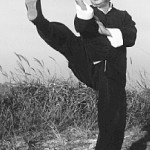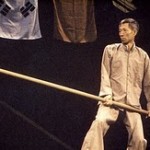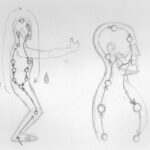Hawkins and Bruce meet up again in the middle
Bruce Lee Discovers Jeet Kuen Do:
Bruce Lee went back to Hong Kong to learn more from his teacher, the great Yip Man. He returned to the United States with a new art called Jeet Kune Do.
By Hawkins Cheung, as told to Robert Chu First published in Inside Kung-Fu 91/12
After Bruce left Hong Kong, I went to Australia to attend college. We still stayed in touch by writing to each other. He told me he was working part time at Ruby Chow’s restaurant in Seattle and teaching a few students wing chun as well as some of Uncle Shiu’s northern style kung-fu high kicks. He wrote that he loved wing chun very much and he wanted to go back to Hong Kong to learn the rest of the system.
He told me to carry on with wing chun and not to give up. Actually I didn’t have the time to give up my wing chun. I arrived in Sidney, Australia, in the late 195Os. Just 14 years after World War II, Australia had suffered much from the Japanese occupation. I found myself involved in fights because at that time there was a great resentment for Japanese. They always confused the Chinese for Japanese. Sometimes, I had to fight against people twice my size to stay alive. Many Southeast Asians also attended the university in Australia. At times, racial tension and cultural differences would result in violence. Fights would start up without warning. I had trouble with a few Thai boxers.
They would call themselves “prize-fighters” — they fought for prizes, I fought for my life. The Thai’s were hard to fight because they seemed to have four hands. I wrote Bruce about these fighting experiences. I learned how to apply my wing chun against multicultural martial arts. Bruce told me if had any problems in Australia to come to the United States and study. He would take care of me.
I returned to Hong Kong in 1964. One day, as I was ready to drive my car out of my parking space in the street, I saw someone toward my left window. I couldn’t see this person’s face. I thought that this person was loocking for trouble, and I opened the car door ready to fight. I then saw it was Bruce. I was so happy to see him, and just as I was about to say “Hello!” he said’ “Hawkins, stand here, I have something to show you.” Bruce stepped back two steps and suddenly charged in very quickly. I was surprised that his movement was so fast.
Another surprise was that Bruce’s character hadn’t changed at all. He still wanted to be top dog. He still wanted to show off. If he liked you, he would always tell you what was on his mind.
If he didn’t like you, he’d be very tricky to deal with. Bruce had that rare ability to draw your attention somewhere else. Sometimes yon didn’t know what he was thinking. I was often suspicious if Bruce was too nice; it meant he wanted something or was about to take advantage of you. This character made people like him, and at the same time, made it easy for me to trick him.
I asked him how he developed the ability to close in that quickly. He said’ “look, Hawkins, in the United States you don’t have any good training partners to practice wing chun with. You can say that my wing chun is better than any so called wing chun masters there. I can’t go any further. But I have had a lot of challenge fights. My opponents are fast, so I have to be faster; they’re strong, so I have to he stronger than them. There’s no other way, because in the U.S., I’m a ‘gung-fu’ guy. Because my wing chun is limited and my structure can’t hold up against larger opponents, I have to use no way as the way, no limitation as the limitation.”
That was the first time I heard Bruce say that. There is a Chinese saying Called, “Bik fu tiu cheung,” meaning, “The cornered tiger has to jump over a wall.” It is the equivalent of saying, “Having no way out” in English. I realized that Bruce felt frustration in his martial arts training. Although Bruce was becoming Westernized, he still felt pride that he was Chinese and he never wanted to appear inferior when comparing Chinese gung-fu with other nations’ martial arts.
Bruce continued: “I have to train very hard to beat my opponents. So I’ve come back to further my training in wing chun, and I hope to learn more of the dummy techniques from the old man (Yip Man). Hopefully, sifu will let me film him on 8mm so that I may show my students in the U.S.” Bruce said his acting career was beginning to take off. “By the way,” he noted, “I just signed a contract with 20th Century Fox to do a ‘Charlie Chan’ movie (it later turned out to be the “Green Hornet” series). I’m on my way to see the old man now.” I knew that when he wanted to accomplish a task, I’d better not get in his way, so I left.
A few days later, Bruce gave a demonstration on a popular talk show on television. Bruce didn’t mention anything about wing chun, but referred to his art simply as “gung-fu.” I realized that something must have happened between Bruce and Yip Man. I knew Bruce’s character, and when he desired or wanted something accomplished, no one could stop him. if not, Bruce would go out on his own to get the job done. Bruce would then come back and show you and try to embarrass you.
I found out that the “old man” refused his request to be filmed doing the dummy set. I knew that the “old man” was very Chinese tradition minded and that Bruce was very direct and Western in his thinking. Bruce wanted to learn everything overnight, but the ‘old man” felt you had to train to get it. later on, I found that Bruce formed his own method and called it ‘jeet kune do.”
During 1966, a friend and I were involved in bringing Japanese karate to Hong Kong. I found myself having to change when sparring with the Japanese karate instructors; their attacks were very fast with emotionally charged quickness. They would attack and disappear as quickly as they came. Their punches were so quick that when I attempted to pak sao, they would retract their punch and I couldn’t connect. When I tried to step in, they would use a front kick. I found that defensively, I was fine, because they found it difficult to land on me. But when it came to attacking, I was unable to score. I became frustrated with this type of sport fighting. It differed from real fighting in that it emphasized skill, not just guts and endurance.
I remembered what Bruce had said about his “opponents being fast, but he had to be faster; opponents being strong, and he having to being stronger.” Then I thought, these Japanese karate instructors train years to develop their speed and power. If I were to train as Bruce did, I would have to spend two or three times as much time to beat them at their own game. But I also had a limitation of power because of my size. If I sped up my wing chun straight punch, I found myself unable to reach my opponent because I was used to the wing chun back horse stance. And if I utilized karate’s front stance, I could reach my opponents, but in turn, I lost my wing chun structure. I found myself in a dilemma, as I would literally throw myself forward to reach my opponent. This may have worked well against a one-punch kill stylist, but I often wondered what would happen if I fought another gung-fu stylist or a street-fighter and they could take my best punch. If I managed to land my best punch and the opponent kept coming, I would certainly be in big trouble.
I wanted to keep my wing chun structure. I asked myself how could I hold back or stop a bigger opponent charging at me without that structure? The structure was also important to handle combination-type fighters. I also asked myself what would happen when I get older and my speed and power have decreased? It would mean that I would have nothing when I’m old.
I couldn’t take my dilemma to my wing chun seniors. They didn’t like the fact that I practiced karate. They didn’t understand that while I practiced karate, I could sharpen my skills against a legal opponent. Karate’s sparring allowed me to get legal fight experience. (In the old days, Chinese martial artists would test out their skills in illegal fights termed “gong sao”- which literally meant “talking hands.” Outsiders who watched me thought that I was doing karate; the instructors didn’t realize I used wing chun to combat my karate opponents. later on, I found a way to adapt my wing chun to their way of fighting. Bruce would throw his power hand out with his high speed and timing to intercept the opponent’s punch or kick. I thought, why don’t I throw my wing chun structure forward with one hand intercepting while the other attacked at the same time? My time training in karate gave me a good chance to develop my new method. Every year, Japan sent new Japanese instructors to Hong Kong to teach. I was always the first guy to fight with the new Japanese instructors. They knew me in the school as the “Chinese boxer.”
Thanks to Bruce’s ideas’ I learned how to handle my opponents. My way didn’t mean other wing chun practitioners did the same; but I developed my way to satisfy myself and keep my beloved wing chun style. I was able to make the wing chun style alive and understand the wing chun concept in combat. Bruce’s way of the intercepting fist (jeet kune do) is one of the principles of wing chun. Bruce’s standard was limited; he made intercepting into his concept because of the circumstances he told me of during his last Stay in Hong Kong. Before he died, he told me that “jeet kune” meant Pak sao in wing chun or intercepting an opponent’s punch before it landed on you. I asked him if he meant to create another style. Bruce firmly told me, “No! It is only the expression of the motion! You can say it is my expression of the pak sao in wing chun (note: Pak sao is one of the fundamental movements from wing chun and depending upon circumstance, it may be offensive or defensive in nature.) I didn’t betray sifu, I didn’t betray Chinese martial arts. I wanted to show others the application way of jeet kune. I wanted to prove I could stop their fast attacks coming at me.”
I knew Bruce’s character. I knew he wanted to prove what he said was right and that he would prove it to wing chun people as well as the world, that he was top dog. Bruce would always change his way of fighting to improve himself to be the best. I never read his books or books that others wrote about him, but I would watch his application whenever I could in his real fights or as an actor in his movies. I found his martial arts to have two versions: one in real life and one in his movies. In real life, Bruce’s speed and power would scare his opponents and would prove what he called “jeet kune.” His movie version would show his showmanship with fancy movements to satisfy his fans. I didn’t see his “jeet kune” action in his movies.
I believe those who knew Bruce Personally could tell his moves were sharp, clear and to the point. People who didn’t know Bruce in person were attracted by his action movies and philosophy. I have been in the U.S. for 12 years now. I have seen many of Bruce’s students and grand students change a lot of his way, even when they don’t even understand what the original meaning or essence of his “jeet kune do.” Some have even gone on to teach jeet kune do as a style! Some of them claim to be teaching jeet kune do and add their own personal style, calling it “JKD so-and-so.”
To my memory, Bruce explained that jeet kune do was the method of intercepting or cutting off an opponent’s action. So jeet kune do was the method of striking an opponent as the opponent attacked. The concept of intercepting or cutting is used in all systems of martial arts. if you don’t want to get hit, you’d better cut off or block an attack without running from or skipping away. Each style or person will demonstrate intercepting in a different manner. Bruce demonstrated in his personal attitude because of his emotional anger and hunger for winning character. He simply wanted to be the best and would accept nothing else. That is the trademark of Bruce’s style or action in entry. Only Bruce could do that.
Bruce changed his methods for the job on hand, not for you or me He became an expert in intercepting or cutting off an opponent’s attack. He had to continually train to prove what he said about “jeet kune.” if Bruce couldn’t intercept, he would have to take back the name “jeet kune do.” But he did prove it. He desired to keep the name “jeet kune do” while he was alive. Since he is now dead, it is up to his students to continue giving Bruce credit. The question is whether they can prove they can “jeet kune” for him and the public.
We don’t care how Bruce’s students change their way; we want to see someone as good or better than Bruce lee in action, not another style or way. if your results are different from what Bruce did you are not preserving jeet kune do. if you keep the name jeet kune do, then you should strive to become an expert in intercepting. Don’t down grade Bruce’s memory with your own way. This is not his creation. Just as wing chun people have recognizable trademark in application, those who follow Bruce’s way should also have a recognizable concept: that of intercepting.
Source: www.hawkinscheung.com











